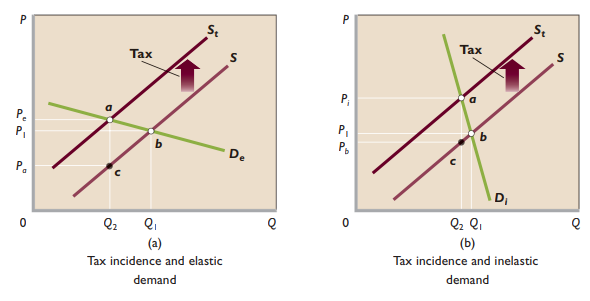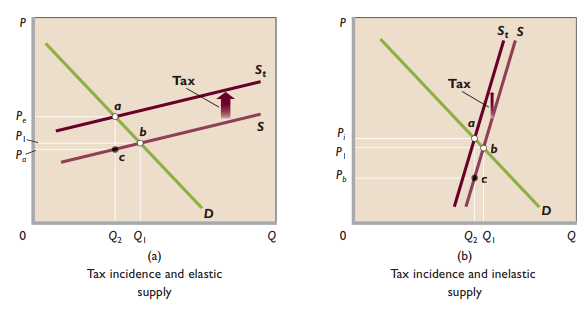
Chapter 17: Public Choice Theory and the Economics of Taxation
Public choice theory - Economic analysis of government decision making, politics, and elections
Revealing preferences through majority voting
Decisions about regulation of businesses, income distribution, etc.
Made through majority voting
Vote for officials who represent collective wishes
Inefficient voting outcomes
Inefficient “no” vote → Too little of public good produced
Inefficient “yes” vote → Too much of public good produced
Majority voting cannot incorporate strengths of each person’s preferences
Interest groups - People who share strong preferences for a public good may band together into interest groups and use advertisements, mailings, and direct persuasion to convince others of the merits of that public good
Logrolling - Trading of votes to secure favorable outcomes
“Vote for my special local project and I will vote for yours”
Paradox of voting - A situation in which society may not be able to rank its preferences consistently through paired-choice majority voting
Under some circumstances majority voting fails to make consistent choices that reflect the community’s underlying preferences
Median-voter model - Under majority rule and consistent voting preferences, the median voter will in a sense determine the outcomes of elections
Median voter is person holding middle position
Political candidates appeal to median voter to get nomination
Info about people’s preferences is imperfect → Politicians can misjudge true median position
Government failure - Inefficiency due to certain characteristics of the public sector
Special-interest effect - Any outcome of the political process whereby a small number of people obtain a government program or policy that gives them large gains at the expense of a much greater number of persons who individually suffer small losses
Pork barrel politics - Securing gov’t project that yields benefits mainly to a single district/political representative
Earmarks - Narrow, specifically designated authorizations of expenditure
Logrolling - “Vote for my special local project and I will vote for yours”
Rent seeking - Appeal to government for special benefits at taxpayers’ or someone else’s expense
Politicians favor programs w/ immediate benefits + reject programs w/ very high long-term benefits
The citizen as a voter is confronted with, say, only two or three candidates for an office, each representing a different “bundle” of programs (public goods and services). None of these bundles of public goods is likely to fit exactly the preferences of any particular voter. Yet the voter must choose one of them.
Bureaucracy + inefficiency
Gov’t agencies + managers have no incentive to be efficient
Gov’t bureaucrats justify continued employment by creating + pretending to solve problems
Imperfect institutions
Is an activity performed w/ greater success in private or public sector?
Apportioning the tax burden
Benefits-received principle - Households and businesses should purchase the goods and services of government in the same way they buy other commodities
Those who benefit most from government-supplied goods or services should pay the taxes necessary to finance them
Cannot be applied to income redistribution programs
Ability-to-pay principle - Tax burden should be apportioned according to taxpayers’ income and wealth
Types of taxes
Progressive tax - If its average rate increases as income increases. Such a tax claims not only a larger absolute (dollar) amount but also a larger percentage of income as income increases.
Personal income tax
Regressive tax - If its average rate declines as income increases. Such a tax takes a smaller proportion of income as income increases. A regressive tax may or may not take a larger absolute amount of income as income increases.
Sales tax
Payroll taxes
Property taxes
Proportional tax - If its average rate remains the same regardless of the size of income
Corporate income tax
Tax incidence - Final resting place of a tax (who pays it?)
More inelastic demand → Larger portion of tax shifted to consumers
More inelastic supply → Larger portion of tax shifted to producers


Efficiency loss of the tax - This loss is society’s sacrifice of net benefit, because the tax reduces production and consumption of the product below their levels of economic efficiency, where marginal benefit and marginal cost are equal
Demand more elastic → Efficiency loss greater
Probable incidence of US taxes
Incidence of personal income tax is on individual
Incidence of corporate income tax is on company’s stockholders
Incidence of property tax is on property owner
US tax structure
Federal tax system is progressive
State + local tax structures are largely regressive
Overall US tax system is slightly progressive
Chapter 17: Public Choice Theory and the Economics of Taxation
Public choice theory - Economic analysis of government decision making, politics, and elections
Revealing preferences through majority voting
Decisions about regulation of businesses, income distribution, etc.
Made through majority voting
Vote for officials who represent collective wishes
Inefficient voting outcomes
Inefficient “no” vote → Too little of public good produced
Inefficient “yes” vote → Too much of public good produced
Majority voting cannot incorporate strengths of each person’s preferences
Interest groups - People who share strong preferences for a public good may band together into interest groups and use advertisements, mailings, and direct persuasion to convince others of the merits of that public good
Logrolling - Trading of votes to secure favorable outcomes
“Vote for my special local project and I will vote for yours”
Paradox of voting - A situation in which society may not be able to rank its preferences consistently through paired-choice majority voting
Under some circumstances majority voting fails to make consistent choices that reflect the community’s underlying preferences
Median-voter model - Under majority rule and consistent voting preferences, the median voter will in a sense determine the outcomes of elections
Median voter is person holding middle position
Political candidates appeal to median voter to get nomination
Info about people’s preferences is imperfect → Politicians can misjudge true median position
Government failure - Inefficiency due to certain characteristics of the public sector
Special-interest effect - Any outcome of the political process whereby a small number of people obtain a government program or policy that gives them large gains at the expense of a much greater number of persons who individually suffer small losses
Pork barrel politics - Securing gov’t project that yields benefits mainly to a single district/political representative
Earmarks - Narrow, specifically designated authorizations of expenditure
Logrolling - “Vote for my special local project and I will vote for yours”
Rent seeking - Appeal to government for special benefits at taxpayers’ or someone else’s expense
Politicians favor programs w/ immediate benefits + reject programs w/ very high long-term benefits
The citizen as a voter is confronted with, say, only two or three candidates for an office, each representing a different “bundle” of programs (public goods and services). None of these bundles of public goods is likely to fit exactly the preferences of any particular voter. Yet the voter must choose one of them.
Bureaucracy + inefficiency
Gov’t agencies + managers have no incentive to be efficient
Gov’t bureaucrats justify continued employment by creating + pretending to solve problems
Imperfect institutions
Is an activity performed w/ greater success in private or public sector?
Apportioning the tax burden
Benefits-received principle - Households and businesses should purchase the goods and services of government in the same way they buy other commodities
Those who benefit most from government-supplied goods or services should pay the taxes necessary to finance them
Cannot be applied to income redistribution programs
Ability-to-pay principle - Tax burden should be apportioned according to taxpayers’ income and wealth
Types of taxes
Progressive tax - If its average rate increases as income increases. Such a tax claims not only a larger absolute (dollar) amount but also a larger percentage of income as income increases.
Personal income tax
Regressive tax - If its average rate declines as income increases. Such a tax takes a smaller proportion of income as income increases. A regressive tax may or may not take a larger absolute amount of income as income increases.
Sales tax
Payroll taxes
Property taxes
Proportional tax - If its average rate remains the same regardless of the size of income
Corporate income tax
Tax incidence - Final resting place of a tax (who pays it?)
More inelastic demand → Larger portion of tax shifted to consumers
More inelastic supply → Larger portion of tax shifted to producers


Efficiency loss of the tax - This loss is society’s sacrifice of net benefit, because the tax reduces production and consumption of the product below their levels of economic efficiency, where marginal benefit and marginal cost are equal
Demand more elastic → Efficiency loss greater
Probable incidence of US taxes
Incidence of personal income tax is on individual
Incidence of corporate income tax is on company’s stockholders
Incidence of property tax is on property owner
US tax structure
Federal tax system is progressive
State + local tax structures are largely regressive
Overall US tax system is slightly progressive
 Knowt
Knowt
